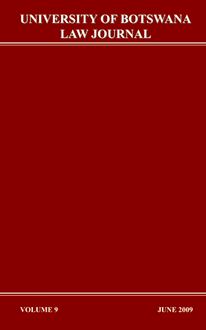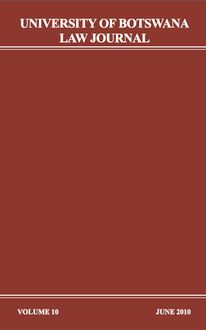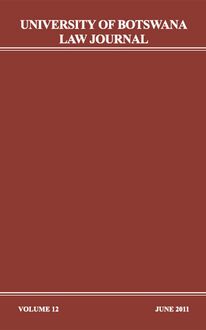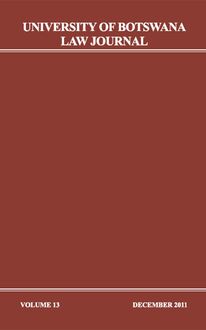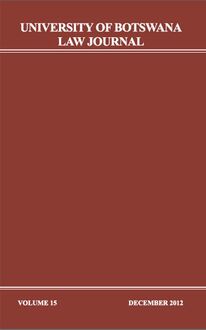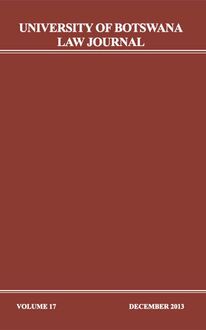The University of Botswana Law Journal is a peer refereed journal published twice a year. It provides a forum for scholars and practitioners to reflect on diverse legal issues of national, regional and international significance and of local and regional relevance.Editorial Board:Prof. C. M. Fombad Editor-in-Chief, University of Botswana.Mrs. E. Macharia-Mokobi Secretary, University of Botswana.Dr. K. Solo University of Botswana.Prof. C. Ngongola University of Botswana.Prof. J. Kiggundu University of Botswana.Prof. E. K. Quansah University of Botswana.Dr. O. B. Tshosa University of Botswana.Mr. T. Sebogo Vice chairman, Law Society of Botswana
Voir
UNIVERSITY OF BOTSWANA LAW JOURNAL
VOLUME 9 JUNE 2009
ARTICLES
Peacekeeping in Africa: Problems and Prospects..............................................3 L. Juma
Some Contemporary Challenges Facing Family Law in Botswana.................25 E.K. Quansah
From the Organisation of African Unity to the African Union: Rethinking the Framework for Inter-state Cooperation in Africa in an Era of Globalisation.....................................................................49 T. Maluwa
Namibian Land Law: Law, Land Reform and the Restructuring of Post-Apartheid Namibia.......................................................87 S.K. Amoo & S.L. Harring
Botswana
Lesotho
Nigeria
South Africa
RECENT LEGAL DEVELOPMENTS
-
-
-
-
E.N. Macharia-Mokobi...........................123
Q. Letsika................................................135
A.O. Enabulele........................................141
A. Anderson............................................155
2 UNIVERSITY OF BOTSWANA LAW JOURNAL JUNE 2009
ARTICLES
3
Peacekeeping in Africa: Problems and Prospects
ABSTRACT
L. Juma*
Against the background of an expanded need for peacekeeping, the complexity that its programmes entail, and the belief that it will endure for a long time to come, this article discusses the propriety of international peacekeeping operations, its inherent features and weaknesses in creating or preserving peace, and the role that regional organisations play, or should play, in its enhancement. The article traces the history, albeit in brief, of peacekeeping in the continent while acknowledging the political and economic changes that have transformed its programmes. It also appraises the successes and failures against the background of the challenges that peacekeeping operations have had to contend with. Overall, the article draws the conclusion that much of what will become of peacekeeping in the future will depend on the reform of the UN Security Council and the level of participation of the African Union and sub-regional organisations in peacemaking and peacebuilding initiatives on the continent.
1.
INTRODUCTION
The single most emphatic response to African conflicts by the international 1 community has been through peacekeeping operations. Beginning with the truce supervision programmes of the United Nations early years, peacekeeping operations have matured into complex forms of interventions with multi-dimensional approaches to conflict abatement, human rights enforcement and 2 even regime stabilisation. This evolutionary trend has been rendered on the one hand, by the complicity of globalisation trends and the expansion of the neo-liberal agenda after the demise of the Cold War, and on the other, by the 3 rise of complex internal conflicts, mostly on the African continent.
1
2
3
Associate Professor of Law, Rhodes University. With over 54 missions established world wide since 1948, the prominence of peacekeeping as an instrument of international peace and security cannot be overstated. In 1988, UN peacekeepers were awarded the prestigious Nobel Prize in recognition of their contribution to world peace. S. Ratner, “Peacemaking, Peacekeeping and Peace Enforcement: Conceptual and legal Underpinnings of the UN Role — An American Perspective,” in S. Harrison and M. Nishihara eds.,UN Peacekeeping: Japanese and American Perspective,Washington DC, Carnegie Endowment for International Peace (1995), pp. 17-30; Roy Lee, “United Nations Peacekeeping: Development and Prospects,” 28Cornel International Law Journal(1995), p. 619. T. Neethling, “International Peacekeeping Trends: The Significance of African Contributions to African Peacekeeping Requirements,” 31(1)Politikon(2004), p. 49 at 50. For the change in the nature of conflicts see, generally, M. Kaldor,New and Old Wars: Organized Violence in a Global Era, Cambridge, Polity
4 UNIVERSITY OF BOTSWANA LAW JOURNAL JUNE 2009
Unfortunately, this evolution has engendered considerable criticism, especially 4 on its viability as conflict reduction and stabilization mechanism. But this is not entirely without cause. Invariably all UN peacekeeping operations in 5 Africa have been poorly managed, with Somalia providing a perfect example. In other cases, UN response to peacekeeping needs have been slow or simply 6 absent, like in Rwanda. But the greatest frustration has been the inability of peacekeeping operations to create conditions for sustainable peace. Civil wars in Angola, DR Congo, and even Somalia have continued for a long time with 7 peacekeepers on the ground. Recently, analysts have pointed to the worsening situation in Darfur despite the presence of the UN/AU peacekeeping forces on 8 the ground. Thus, the overall picture that seems to be associated with international peacekeeping is that of dismal resources, incongruence of mission, and even apathy to African problems. Despite these weaknesses and problems, the need for peacekeepers has not abated. Currently, many nations and humanitarian organisation are 9 demanding for an increased UN involvement in DR Congo. The political crisis in Ivory Coast and the humanitarian crisis currently developing in Zimbabwe have equally attracted calls for peacekeeping interventions. In
3
4
5
6
7
8
9
Press (1999); K. Holsti,The State, War, And The State Of War, Cambridge, Cambridge University Press (1996), pp. 19-40. See for example A. Roberts, “The Crisis in UN Peacekeeping,” in C. Crockeret aleds.,Managing Global Chaos, Washington DC, US Institute of Peace (1996) p. 299; R. Wilde, “Taxonomies of International Peacekeeping: An Alternative Narrative,” 9ILSA Journal of International & Comparative Law(2003) p. 391; R. Thakur and C. Thayer eds.,A Crisis of Expectations: UN Peacekeeping in 1990s, Boulder Co, Westview (1995). See also, “The Future of peacekeeping,”New York Times, 8 January 1995 at A24. The editors, while calling on the UN to rethink its peacekeeping strategies so that there can be a “shift back toward more limited objectives like policing cease-fires, asserted that the traditional peacekeeping was good: It makes no sense to continue eroding its credibility by asking it to do what it cannot.” See M. Bryden, ‘Somalia: Wages of Failure’ 94Current History, (1995) p.145; J. Drysdale,Whatever Happened to Somalia? A Tale of tragic BlundersLondon, HAAN Associates (1994); Martin Meredith, The Fate of Africa: From the Hopes of Freedom to the Hearts of Despair, New York, Public Affairs (2005) pp. 470-484; M. Huband,The Skull Beneath the Skin: Africa After the Cold War, Boulder Co, Westview (2001) pp. 277-306; Michael Marren, “Somalia: Whose failure?” 95Current History (1996) pp. 201-205. See generally, M. Mamdani,When Victims Become Killers: Colonialism, Nativism, and the Genocide in Rwanda, Princeton, Princeton University Press (2001); P. Gourevitch,We Wish to Inform you that Tomorrow We Will be Killed with Our FamiliesNew York, Farrar Straus & Giroux (1999); G. Prunier, The Rwanda Crisis: History of a GenocideNew York, Columbia University Press (1995). A. Robertsloc.cit.in note 4; K. Emizet, “The Massacre of Refugees in Congo: A Case of UN Peacekeeping Failure and International Law,” (2000) 38(2)Journal of Modern African studies(2000), pp. 163-202. Srebrenica in 1995, which is still remembered as one of the UN’s most appalling peacekeeping blunders. One analyst has summed it up as follows: “Srebrenica was militarily indefensible, but only because the UN military deterrent operated under ambiguous and unweidly rules designed less to protect Bosnians than to avoid western casualties and obscure the accountability of western governments.”See Charles Lane,New Republic, 14 August 1995. See also, the Report of the UN Secretary General to the General Assembly, “The Fall of Srebrenica” 15 November 1999 (available at http://www.un.org/peace/ srebrenica.pdf); See also, Jean-Marie Guéhenno, “On the Challenges and Achievements of Reforming UN Peace Operations,” 14(2)International Peacekeeping(2002), p. 69 at 72. See “More EU Peace keepers Deployed in DRC”RTE News, 22 August 2006 (available at http:// www.rte.ie/news/2006/0822/congo.html); “Thousands more UN troops needed in DRC”CAFOD News 23 March 2005 (available at http://www.cafod.org.uk/news_and_events/news/drc_2005_03_23). For a detailed analysis of the conflict see G. Nzongola-Ntalaja,The Congo: From Leopold to Kabila, New York, Zed Books (2003); L. Juma, “The War in Congo: Transnational Conflict Networks and the Failure of Internationalism” 10 (2)Gonzaga Journal of International Law(2006), pp. 97-162 (available at http:// www.gonzagajil.org).
PEACE-KEEPING IN AFRICA5
Somalia, a renewed interest by the international community accentuated by the fear that terrorist elements may have infiltrated the leadership ranks of the Islamic Courts, a group of fundamental Islamist group staking leadership to a greater portion of the country, has already spurred the African Union (AU) 10 into sending a paltry contingent of peacekeepers there. Given these developments, and the fact that the community of world nations by and large still share the view that the UN should play the central role in matters of international security, peacekeeping is unlikely to vanish from the 11 international peace agenda anytime soon. Considering too, that the terminology of peacekeeping is slowly expanding to encompass conflict resolution strategies that hitherto had no recourse to the international system, the movement towards its reform is likely to overshadow any quest for its abandonment. And with continental efforts revealing acute paucity of resources needed to sustain lengthy engagements in conflict zones, the role of UN is likely to remain central to any peacekeeping programmes in Africa. It against this background that this article examines the major constraints that attends to UN peacekeeping in Africa. It takes the view that peacekeeping could be an essential feature in peace-building, human rights enforcement and humanitarian intervention processes if its conceptual base were fortified with a strong normative regime, and its operational aspects matched with adequate resource and structural support.
2.
THE NATURE OF INTERNATIONAL PEACEKEEPING
Peacekeeping evolved from a climate of international incongruity rendered by the Cold War superpower standoff. This climate, diminished the UN Security Council’s ability to make effective use of pacific measures to resolve conflicts and/or enforce peace, and threatened to make the entire UN system irrelevant 12 to world security, and its peace functions, moribund. But world leaders, keen to preserve the image of the organisation, created a role for it in conflict resolution by devising a system of using impartial and non combative force to maintain ceasefires. The idea was based on the assumption that the interposition of “neutral” soldiers between two warring groups may reduce the chances of renewed combat, calm heated passions and ultimately deliver peace. Thus, international peacekeeping was born, and its first soldiers sent to
10
11
12
The African Union Mission to Somalia (AMISON) was created in January 2007 by the AU’s Peace and Security Council. It is now composed of soldiers from Uganda, Nigeria, Malawi, and Burundi. See also F. Fall, ‘UN Security Council Resolution 1744 (2007) Authorising the AU Mission in Somalia (AMISON)’ 14(5)International Peacekeeping(2007), pp. 675-678. GA Res 58/317 adopted on 5 August 2004 where member states affirmed the role of the UN in the maintenance of peace and security. See generally, R. Higgins,United Nations Peacekeeping: Documents and Commentary(4 Vols.) Oxford, Oxford University Press (1969-1981).
6 UNIVERSITY OF BOTSWANA LAW JOURNAL JUNE 2009
the Balkans in 1947 under the banner of the UN Special Mission to the Balkans 13 (UNSCOB). A year later, the UN dispatched military personnel from its 14 headquarters to the Middle East under the Truce Supervisory Organisation. Since then, peacekeeping has become a major component of the UN’s work around the world. Studies have now identified five to seven different epochs in 15 the continuum of the UN peacekeeping involvement the world over. The first period was between 1946 and 1956 and is often described as the nascent period; 1956 to 1967, the assertive period; 1967 to 1973 as the dormant period; 1973 to 1978 as the resurgent period; 1978 to 1993, the maintenance period; 1988 to 1993, the expansion period. Recently, Dennis Jett has labelled the 16 period between 1993 to present day as the period of contraction. Peacekeeping most invariably follow the conclusion of a peace agreement or accord. It does not bring about agreement between the fighting groups, but assists in implementing the agreements already reached. This may occur in situations where parties have agreed to a temporary cessation of hostilities, and the presence of a neutral force will then act as a deterrent measure. Also, it may create a favourable atmosphere for the implementation of other terms of the agreement. In the early days, it was anticipated that these objectives could be achieved without the use of force. However, modern manifestations have seen a continued increase of situations where UN 17 peacekeepers are called upon to use force. Thus, even though the United Nations strategy in internal wars has always been to deny both combatants victory and to persuade them that “the use of force to resolve dispute will not succeed,” as suggested by John Ruggies, peacekeeping is an undertaking that 18 today exceeds the mere stabilisation of a conflict situation. That is why the term peacekeeping has become the “catch all” phrase that encompasses a varying range of tasks which UN forces in a conflict arena are often called to do. In Africa, UN peacekeeping activities have included the general freezing of conflict and maintenance of ceasefires; assisting in disarmament and decommissioning in DR Congo and Sierra Leone; monitoring of elections in Namibia; assisting in the delivery of humanitarian services in the DR Congo and Somalia; reporting on violations of human rights in DR Congo. In some cases they have even prepared the groundwork for the establishment of an
13
14 15
16 17
18
R. Rotberg, “Peacekeeping and Effective Prevention of War,” in R. Rotberg ed.,Peacekeeping and Peace Enforcement in Africa: Methods of Conflict Prevention, Washington DC, World Peace Foundation (2000), p. 3. Ibid. See H. Wiseman,The United Nations and International Peacekeeping: A Comparative Analysis, in the United Nations and the Maintenance of International Peace and Security, UNITAR, (1987), pp. 264-99. See D. Jett,Why Peacekeeping Fails, New York, Palgrave Macmillan (1999), pp. 22-23. See generally, J. Helderman, “Legal Basis for United Nations Armed Forces,” (1962) 56AJIL(1962), p. 971; D. Bowett,United Nations Forces: A Legal StudyLondon, Stevens (1964), p. 485. J. Ruggie, “Wondering in the Void: Charting the United Nations’ New strategic Role,” 72 (5)Foreign Affairs(1993), pp. 29-31.
PEACE-KEEPING IN AFRICA7
19 international human rights tribunal.
2.1
The Problem of Definition
Despite its prominence, peacekeeping still lacks a proper definition. The word peacekeeping does not appear even once in the UN Charter’s 111 articles. One might argue that the general absence of a formal Charter framework for all peacekeeping operations renders them flexible and thus adaptable to conditions of difficulty upon which they are deployed. But given that the UN functions on the basis of consent and impartiality, the lack of uniformity portends a great risk. Ironically, this is precisely the reason why the UN sponsored Intergovernmental Committee on Peacekeeping Operations, rejected the idea of putting a precise definition on the term. Doing so, they argued, would impose “a straitjacket on a concept whose flexibility made it the most 20 pragmatic instrument at the disposal of the world organisation.” But, such broad use of the term, implied by the lack of concrete legal definition has bred misconceptions and confusion among the players in any arena of conflict – a fact that has limited the debate as to the legal responsibility of a peacekeeping operation or what exactly it ought to accomplish. The misconception may somewhat be a product of deliberate policy machinations of the UN and its collaborators meant to relegate concerns as to the quality of UN engagements in conflict zones and the prospects of establishing a more permanent rapid response force away from the mainstream of international security debate. But, defining the role peacekeepers are expected to play is key to the elimination of false expectations and the determination of the overall success of any 21 mission. Despite the want of definition, a little inference can be drawn from Article 43 which enjoins member states to contribute to the maintenance of international peace and security by undertaking to make available to the Security Council their armed forces and other military resources. Although the formal recognition of peacekeeping as an instrument of international security came in 1965 with the establishment of the Special Committee on
19
20
21
Rwanda after the genocide and Sierra Leone after the civil war are good examples. See P. Akhavan, “The International Criminal Court for Rwanda: The Politics and Pragmatics of Punishment,” 90AJIL(1996), p. 501; L. Juma, “The Human Rights Approach to Peace in Sierra Leone: The Analysis of the Peace Process and the Human Rights Enforcement in a Civil War Situation,” 30Denver Journal of International Law (2002), p. 325. SeeS. Tharoor, “The Changing Face of Peacekeeping and Peace Enforcement,” 19Fordham International Law Journal(1995), p. 408. US Senator John McCain in reference to the Somali debacle lamented, “Neither the UN Secretary General, the Security Council, the General Assembly, nor for that matter, the Clinton administration could define the concept in the same way one day to another or from one country to another. To the Americans, peacemaking in Somalia meant feeding a starving people. To the UN Secretary General it meant war lord hunting.” See J. McCain, “The Proper United States Role in Peacemaking,” in D. Quin ed.,Peace Support Operations and the US Military, Washington DC, National Defence University Press (1994), p. 97.
8 UNIVERSITY OF BOTSWANA LAW JOURNAL JUNE 2009
22 Peacekeeping Operations, still, there has been no clear definition. But the term has gained acceptance within diplomatic circles, international legal community and even within the UN itself as general reference to “the prevention, containment, moderation and termination of hostilities between or within states, through the medium of peaceful third party intervention organized and directed internationally using a multinational force of soldiers, 23 police and civilians to restore and maintain peace.” Goulding has defined it as a military operation by and under the command of the UN carried out with the consent of parties concerned to help resolve the conflicts between them, but at “the expense collectively of member-states, and with military and other personnel and equipment provided voluntarily by them, acting impartially 24 between parties and using force to the minimum extent necessary.” Boutrous Ghali, in his famous treatise,Agenda for Peace, defined thus:
“The deployment of a United Nations presence in the field, hitherto with the consent of all parties concerned, normally involving United Nations military and/or police personnel and frequently civilians as well. Peace keeping is a technique that expands the possibilities for 25 both prevention of conflict and the making of peace.”
This characterisation extends the meaning to include, preventive diplomacy, peace-making and peace-building. The four correlative terms were coined out of the effort to surmise an understanding of the UN involvement in conflict situation as a composite undertaking with a myriad of objectives. Indeed, such an understanding emerged as early as 1961 when the idea of “preventive diplomacy” was used in reference to the peacekeeping operation launched in Congo. Then, Dag Hammarskjöld, the UN Secretary General articulated the UN role of “preventive diplomacy” as underpinned by several operative conditions. Firstly, there had to be consent from the state in whose territory the force was to be stationed. The implication was that the state on whose soil peacekeeping was being conducted could halt the activity 26 whenever it pleased. Perhaps it is for this reason that the Security Council instituted a practice in 1973 of reviewing the mandate of peacekeeping missions every six months. Secondly, the idea of neutrality was made central to the activity of a peacekeeping. This requirement carried as much
22
23
24
25
26
UNGA Res. 2006 of 18 February 1965. See also, I. Rikhye,The Theory and Practice of Peacekeeping, New York, St. Martins (1984), p. 1. See I. Rikhye,The Thin Blue Line: International Peacekeeping and the Future, New Haven, Yale University Press (1974), p. 43. M. Goulding, “The Evolution of United Nations Peacekeeping,” 69 (3)International Affairsp. (1993), 69. B. Boutrous-Ghali,An Agenda for Peace: Preventive Diplomacy, Peacemaking and Peacekeeping, New York, United Nations (1992), Para. 20. The consent here, would relate to all activities to be carried out under the peacekeeping mandate. Diehl has argued that peacekeeping operations must recognise the sovereignty of states. See P. Diehl, International PeacekeepingBaltimore, John Hopkins University Press (1993), p. 9.
PEACE-KEEPING IN AFRICA9
significance during the cold war as it is today. The neutral image aided the task of creating peace by excluding UN personnel from direct involvement in the conflict. Lastly, the peacekeepers could not initiate the use of force. The UN forces were to rely on the blue flag and helmets, not on weapons, for protection. These operative conditions have all been challenged in the current 27 genre of peacekeeping engagements. For example, the idea of consent is defeated in situations such as Somalia where the state no longer exists, at least 28 in the Weberian sense. When UN forces are called upon to enforce a chapter VII mandate, then obviously the use of force may be part and parcel of their mission. And as we shall see in this article, peacekeeping is evolving and its operations assuming roles that were never envisaged before. These changes, which are a reaction to the complexity of conflicts, indicate an enduring prominence of peacekeeping as a preferred method of dealing with threats to international peace and security, and confirms the agency of a more fully fledged debate on the future of peacekeeping in Africa.
2.2
A Brief History of UN Peacekeeping in Africa
The beginning of UN peacekeeping in the form that we know today was in 1956 when the United Nations Emergency Force (UNEF) was created in 29 response to the deteriorating situation around the Suez Canal. The Suez crisis began when Nasser, the Egyptian President, nationalised the canal and Israel, Britain and France responded by invading and occupying some parts of Egypt. When the USSR condemned the British and France action and US supported its allies, a division was created within the UN Security Council that completely compromised its ability to find solution to the dispute. Thus, it referred the matter to the General Assembly which under the guidance and influence of the Secretary General, Dag Hammarskjöld, voted for the 30 establishment of UNEF. It should be noted however that when the UN
27
28
29
30
See generally, W. Durch eds.,The Evolution of Peacekeeping: Case Studies and Comparative Analyses New York, St. Martins Press (1993); I. Rikhye & K. Skjelsbaek eds.,The United Nations and Peacekeeping: Results limitations and ProspectsNew York, St. Martins Press (1990). R. Patman, “UN Operation in Somalia,” in R. Thakurloc. cit.in note 4 at pp. 95-114; S. Makinda, Seeking Peace From Chaos: Humanitarian Intervention in SomaliaBoulder Co, Lynne Reinner (1993), 18; W. Zartman,Collapsed States: The Disintegration and Restoration of Legitimate AuthorityBoulder Co, Lynne Rienner (1995), 5; G. Helman and S. Ratner, “Saving Failed States,” 89Foreign Policy (1992), p.3 at p. 8. Lester Pearson, the former Canadian Foreign Minister, played a key role in the establishment of the (UNEF) force. In some literature, he is credited with being the founder of modern peacekeeping. See K. Monnakgotla, “The Naked Face of UN Peacekeeping: Noble Crusade or National Self-interest,” 5 (5) African Security Review,(available on the internet at http://www.iss.co.za/pubs/ASR/5No5/ (1996) Monnakgotla.html). Situations in which Security Council could be deadlocked were foreseen much earlier. That is why the General Assembly voted in 1950 to retain residual powers under the less developed doctrine of “uniting for peace.” Under this doctrine, the UN General Assembly can meet within 24 hours to consider the matter and make recommendations, including the use of armed force, to members when necessary. The doctrine was used in the Suez crisis when the General Assembly at an emergency special session, a
10 UNIVERSITY OF BOTSWANA LAW JOURNAL JUNE 2009
Security Council referred the question to the General Assembly no reference 31 was made at all to any article in the Charter. In the final report to the Security Council, the Secretary General affirmed that the operations would be required to conform to the principles of international law. These principles were understood to include the neutrality of the force, its adherence to the enabling resolution, possession only of those rights necessary to carry out its mission, 32 and the requirement of cooperation of the parties to the conflict. Indeed, the Security Council in Resolution 1000 approved these principles to provide guidance in the implementation of the UNEF plan. In Sub-Saharan Africa, the first peacekeeping operation was established in 1960 in the Congo. Like UNEF, the operations in Congo lacked any explicit reference to the Charter. The crisis in Congo had begun soon after 33 its declaration of independence in 1960. The nationalist cause championed by the newly elected Prime Minister, Patrice Lumumba, was challenged by a secessionist movement led by Moishe Tshombe and backed by the Belgian 34 corporate interests. The UN action in Congo was propelled by the geopolitical factors as well as the fledging ambitions of its then Secretary General, Dag Hammarskjöld. Imminent in the Congo was the capitulation of the western capitalist ideology of free trade on the face of an entrenched communist thinking espoused by the new African leaders, more especially, Lumumba. This made Dag Hammarskjöld worry about the future of the 35 “sacred mission” that the western world had towards Africa. But, Hammarskjöld was also an ambitious man who sought a more assertive role for the UN in conflict situations brought about by the ideological polarity of 36 world politics. Thus, when the leaders in Congo appealed for help from the UN to help restore peace in the country, the Security Council readily approved the establishment of United Nations Operations in the Congo (ONUC) mission with an initial mandate of supervising the complete withdrawal of the Belgian forces and to safeguard Congo’s sovereignty. Unfortunately, ONUC became a toothless bulldog in the political quagmire that ensued. Lumumba was murdered in cold blood by factions supported by the US to allow for the ascendancy of Mobutu and his western allied crooks; all these happening in 37 the face of a UN force that had been detailed to maintain the status quo.
30 31 32
33
34
35
36
37
resolution was passed for the establishment of UNEF. See UN Security Council Resolutions 998, 1000 and 1001 of 1956. nd UN Dept. of Public Information,The Blue Helmets: A Review of UN Peacekeepinged. New York,, 2 United Nations (1990), p. 48. R. Edgerton,The Troubled Heart of Africa: A History of the CongoNew York, St. Martins Press (2002), p. 72; J. McCalpin, “Historicity of a Crisis: The Origins of the Congo War,” in John F. Clark ed.,The African Stakes of the Congo War, New York, Palgrave (2002), pp. 33-52. L. De Witte,The Assassination of Lumumba, London, Verso (2001), 31; L. Juma,loc. cit.in note 9 at p. 97. SeeT. Kanza,Conflict in the Congo: The Rise and Fall of Patrice LumumbaRochester VT, Schenkman (1972), p. 220. Some have argued that most of the Secretary General’s actions were influenced by Ralph Mbunche, his American adviser. See L. De Witteloc.cit.in note 34. Ibid.
PEACE-KEEPING IN AFRICA11
After Congo, the UN was involved in Western New Guinea/West Papua (UNSF) and in Cyprus. There were thirteen missions in all in the period between 1949 and 1988. These missions bore the traditional hallmarks of a peacekeeping operation, which was to observe, monitor and report. UN’s involvement during this period had a veritable success considering the nature of conflicts and the political environment existing at the time. According to Roberts, the achievements of the UN during this period was “modest [but] real: they included the freezing although not the resolution of certain conflicts; some reduction of the risk or extent of competitive interventions by neighbours or major powers, and the isolation of some local conflicts from the east-west struggle, so that the local conflicts did not exacerbate the Cold 38 War.” However, after 1988, the nature of conflicts began to change. With the demise of the Cold War, regions of volatility hitherto held together by the superpower standoff erupted, and hostilities within borders escalated into internal wars. In Africa where the immediate post-colonial governments had become autocratic, corrupt and violently opposed to human rights, the end of the Cold War signalled the beginning of a more open and vicious opposition 39 to their rule. Indeed in the 1990’s many of such governments were either democratically overthrown or forced to adopt a more plural approach to political governance. This period witnessed an increased threat to peace, thus 40 increasing as well, the demand for UN peacekeeping forces. Apart from an expanded need for peacekeepers, the nature of peacekeeping itself began to change. Peacekeeping adopted a complex and multi-dimensional approach to peace, mandated in some cases by the agreements or accords signed by the belligerent parties. And because it attained such a broad formulation, virtually all UN actions in conflict situations fell under the rubric of its peacekeeping function. InAn Agenda for Peace, Boutrous Ghali even recommended the use of peace enforcement units especially in case where a ceasefire arrangement needed to be maintained. But this, he insisted, should be done in “clearly defined circumstances and with 41 terms of reference specified in advance.” An example was the stationing of UNPROFOR forces in Macedonia in 1992 to discourage possible attacks 42 against that former Yugoslavia Republic. In 1995, this force in Macedonia having achieved relative success, acquired an independent status and was 43 named UNPREDEP. Its mission ended in 1999.
38 39
40
41 42
43
A. Robertsloc.cit.in note 4 at p. 229. See generally, L. Juma, “Africa, Its conflicts and Its Traditions: Debating a Suitable Role for Traditions in African Peace Initiatives” 13(3)MSU Journal of International Law, (2005), p. 417. A total of 38 peacekeeping missions have been established since 1989 and by 2001, fifteen of them were still operative. See B. Boutros-Ghaliloc. cit.innote 55 Para. 44. See B. Pellnäs, “UN Preventive Deployment in the Former Yugoslav Republic of Macedonia,” in Peter Wallensteen ed.,International Intervention: New Norms in the Post-Cold Era, Uppsala, Uppsala University Press (1997), pp. 107-114. Ibid.
